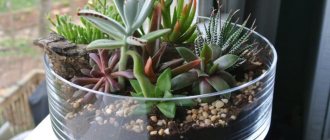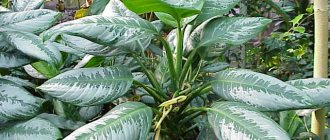Selenicereus chrysocardium is a very popular houseplant, although the species was discovered and described relatively recently. It was discovered in 1951 by Thomas Baillie MacDougall in the tropical rainforests of Mexico. It was only after its first flowering in 1956 in a greenhouse that it was finally described by Edward Johnston Alexander and assigned to the genus Epiphyllum chrysocardium. In 1959, Curt Backeberg introduced it into the genus Marniera (Marniera chrysocardium), but in 1991 this genus was eliminated, and based on the fruits obtained by that time, it was assigned to the genus Selenicereus by Myron Kimnach. However, the systematic position of the species remains unclear and controversial; there is an opinion that it should be returned to the genus Epiphyllum.
This plant leads an epiphytic lifestyle and is easily recognizable even in the absence of flowering. The stems are climbing, branching, flat, up to 30 cm wide, deeply dissected almost to the central vein, which clearly protrudes. The plant can reach several meters in length and occupy a fairly wide space. The blades resemble leaves, up to 15 cm long, up to 4 cm wide at the base, with a sharp ending. The epidermis is green, smooth, sometimes on young shoots there is a reddish tint. The areoles are small, sometimes with small 2-3 bristles, which later fall off. Aerial roots form on the stems; they cling to tree trunks and branches and help the plant climb upward.
The flowers are large, funnel-shaped, very fragrant, up to 35 cm in length and 20-25 cm in diameter, open at night and close in the morning. The outer petals are cream-colored, with a reddish tint, 11-15 cm long and 8-10 mm wide, linear-lanceolate, sharp, wide open. The inner petals are white, 11-14 cm long and 2 cm wide, oblanceolate, acute. In the center there are numerous bright yellow stamens, making the center of the flower appear golden. This gave the species name - chrysocardium, which translated from Latin means “heart of gold”. Flowering occurs in winter, usually on the eve of Christmas and New Year.
For a long time it was not possible to obtain the fruits of this plant in greenhouse conditions, since all existing specimens in cultivation are most likely clones of one original plant, and when pollinated by its own pollen, seed setting and fruit ripening do not occur. In many forest cacti, fertilization with pollen of related species and even genera is possible (which is widely used for breeding hybrid epicacti), but few of these plants bloom in winter. However, in 1981, Eckhard Meier, a famous collector and creator of epicactus varieties, managed to pollinate the spring flower of Selenicereus Golden Heart with pollen from another cactus. As a result, after 11 months, a 7-centimeter green fruit ripened, completely covered with yellowish spines and resembling the fruit of Selenicereus anthonyanus, which was the reason for transferring this plant to the genus Selenicereus. Pollination with foreign pollen does not in any way affect the shape and color of fruits and seeds; they will be identical to fruits of natural origin, their external characteristics depend solely on the mother plant.
This is a truly magnificent plant, its numerous, large carved stems are impressive, and its flowering is simply an unforgettable sight! But even without flowers, this is one of the most beautiful plants. Has a fast growth rate. Shoots of Selenicereus Golden Heart, when grown at home, can be sent up trellises, but it looks much more decorative in hanging baskets. It should be noted that this is a very large plant and it will achieve all its beauty by occupying a fairly large space. But you can also maintain it in a compact form by providing small pots for growth and shortening the length of the stems in time, and then, when the length of the shoots reaches at least 70-90 cm and under proper conditions, you can expect magnificent winter flowering.
What does epiphyllum look like, what family does it belong to?
Epiphyllum is a flower that belongs to the cactus family, there are 20 species. The name is of Greek origin, translated “to the leaf.” This combination of words occurred due to the similarity of the stem in shape with the leaf. The culture is found in the wild in the tropics of South America and the forests of Mexico.
Epiphyllum Monstrosa is sometimes called pink
Common varieties
There are hybrid and natural plant varieties. They differ in the shape of the leaves and the size of the flowers. Many can be grown on the windowsills of apartment buildings if you care for them properly.
- Epiphyllum Marniera is a forest cactus, represented by long, flat shoots that are strongly dissected into leaf-shaped lobes. The diameter of the white flower is on average 25 cm. In the center of the bud there are fluffy golden stamens with a pleasant smell. The plant blooms at night.
- Epiphyllum Monstrosa or Guatemala is notable for its long, twisting stems. For the various shades of light red flowers, this variety is also nicknamed pink epiphyllum.
- Epiphyllum Anguliger grows only in Mexico. The angular epiphyllum received its nickname due to the ornate shape of the stems. The stems can grow up to 1 meter in height, the flowers are large - 15 cm in diameter, and have a pleasant smell. The lower leaves of Epiphyllum anguliger become woody over time.
- Epiphyllum Oxypetalum in nature can grow up to 3 meters long. The plant has flat, narrow, hanging stems that reach a length of 10 cm. The snow-white flowers of Epiphyllum oxypetalum open at night and fill the room with a tart aroma.
- Epiphyllum Ackermann is often found in apartments. The plant is represented by 3-sided hanging stems, along the edges of which there are rounded notches. The leaf blades are 5 cm wide and grow up to 60 cm in length. Up to 15 buds can bloom simultaneously at the tops of the peduncles. The most common red flowers are epiphyllum. Thanks to their ampelous shape, the bushes can be grown in flowerpots, hanging them on the wall.
- Epiphyllum acupetallus was named so for the pointed shape of the stems, which have the shape of narrow, long leaves. The second name is Epiphyllum White, for the exceptionally white hue of the flowers, which in their shape resemble lotuses.
Attention! Many varieties of epiphyllum are suitable for home cultivation. The main thing is to know and follow the rules of flower care.
All varieties of crops require moderate watering and good lighting.
Epiphyllum anguliger has large flowers
Types of epiphyllum with photos and names
Both natural types of epiphyllum and hybrids are grown indoors.
Epiphyllum oxypetalum, or sour petal
The species is most popular in culture. Its large bush can reach a height of about 300 centimeters. The twig-like stems become woody in the lower part over time. They are flat and have a wavy edge; the shoots reach up to 10 centimeters in width. The length of the white flowers is about 20 centimeters, and they reach up to 18 centimeters in diameter. The species has hybrids that differ from each other in the color and size of the flowers.
Epiphyllum anguliger, or angular
The bush is distinguished by its strong branching. Dark green rounded (can be triangular) shoots become woody in the lower part, while in the upper part they are triangular or flat. Their width is 40–80 mm, and their length is about 100 cm. The rich red fragrant large flowers reach about 80–100 mm in diameter.
Hooker's Epiphyllum (Epiphyllum hookeri), or acute petal
It is found naturally in Venezuela, Cuba and Mexico. There the bushes can grow really huge. Large white flowers with a subtle scent are formed on long shoots. The stems are very heavy and therefore bend downwards in an arc.
Serrated epiphyllum (Epiphyllum crenatum)
This is a semi-epiphytic cactus. Its greenish-blue shoots reach about 0.7 m in length and up to 10 centimeters in width. There are many deep cutouts on the edge. The fragrant flowers reach about 15 centimeters in diameter. The species has many hybrids that differ in flower color.
Epiphyllum phyllanthus
This species grows in South America. The length of the stems is about 100 cm, while the length of its secondary leaf shoots is 25–50 cm. The diameter of the pink flowers is 15–18 cm.
Guatemalan Epiphyllum (Epiphyllum guatemalense)
Its shoots look as if oak leaves, each 50 mm in size, were connected together. There is a variety of monstrosa: its shoots can change the shape of the shoots and wriggle in a chaotic manner. The flowers of this species are colored in various shades of pink.
Epiphyllum thomasianum
In wild conditions, the shoots of the plant are about 400 cm long, and in indoor conditions - about 70 cm. The center of the large white flowers is yellow, they reach up to 25 centimeters in diameter.
Epiphyllum ackermanii
The shoots of the plant are drooping. At a height of 40–70 mm from the base, they have multi-toothed flat processes. Fiery red flowers adorn the slender stems.
Epiphyllum laui
This lithophytic and epiphytic species is characterized by rapid growth. In diameter, the main stems reach about 20 mm, and the lateral ones - up to 70 mm. The stems have hair-like spines of a brownish-yellow hue, the length of which is about 0.4 cm. The opening of creamy-white flowers is observed in the evening. The lifespan of each flower is approximately 2 days.
Popular hybrids:
- Unnamed hybrid created by F. Nunn. The center of the flower is white, then it smoothly turns into a pinkish color, and the edge of the petals has a rich purple hue.
- King Midas . The length of the dark green shoots is about 150 cm. Large orange-yellow, almost golden, flowers reach up to 16.5 centimeters in diameter.
- Just Prue . The center of the flowers is pinkish, and the edges of the petals are dark pink. In diameter they reach from 12 to 16 centimeters.
- Johnson . The color of the flowers is dark scarlet.
- Wendy May . The flowers are a deep crimson color and have an unusual shape: the petals growing in the center are short and with rounded tops, and the edges are long and sharp.
- Jennifer Ann . The large flowers have a lemon tint.
- Martina . The cascading shoots are divided into small oval-shaped segments. The fragrant elongated flowers are red in color, with a yellowish center.
EPIPHYLLUM CARE. My Experience for Beginners! /EPIPHYLLUM BLOWING!!!!
Features of caring for a cactus at home
Echinopsis cactus - home care
The flower cannot be moved from its permanent place on a window or wall. The bush may begin to shed buds and flowers.
Temperature
The optimal summer temperature for the flower is 20-25 °C. In autumn, the plant is moved to a cooler room. During the rest period, the heat level in the room should not exceed 15 °C.
Lighting
From the bright sun, the stems of the plant begin to wrinkle and turn yellow. The pot can be placed on the east side; on the south window sill it is necessary to shade the direct rays of the sun. In summer, it is recommended to move the flowerpot outside so that the plant receives more oxygen. But in an open space, the risk of pest infestation increases.
Watering
Watering the bush should be moderate, otherwise it will rot. Before moistening the flower, make sure that the soil in the pot is completely dry. The plant is watered with melted or boiled water at room temperature. In winter, watering is halved; if the room is very cold, watering is stopped altogether.
Long drought leads to drying of shoots and lethargy of leaves. To stimulate the growth of buds, the amount of watering is increased.
Humidity
The plant loves moist air; the stems need to be irrigated daily with a spray bottle. The need for humidity increases if the room where the epiphyllum grows is hot. But a long stay in wet soil can lead to fungal diseases.
The result of excessive watering is the appearance of fungus
Priming
The tropical plant prefers soil rich in mineral elements. You can make the substrate yourself by mixing sand and humus 4 to 1. The soil should be of high acidity.
Feeding
During the flowering period, the plant is fed with cactus fertilizer once every 2 weeks. Fertilizing with a solution of manure in a ratio of 1:4 has a beneficial effect on the ovary of buds.
Maintenance and care at home
Like all representatives of the Cactus family, epiphyllum does not require much attention. However, for normal growth it is necessary to follow basic agrotechnical rules.
Location and lighting
The tropical perennial feels comfortable on western or eastern windows. If there is a lack of light, the intensity of flowering will decrease significantly, and direct sunlight can leave burns on the fleshy stems. Therefore, if the plant is located in the southern part of the house, it must be additionally shaded with a light screen.
Temperature
Phyllocactus does not tolerate sudden temperature changes or drafts. During the growing season, the optimal temperature for it will be +20-25 °C. When the plant enters a dormant period, the indicators are reduced to +10-15 °C.
Watering and air humidity
Homemade epiphyllum requires regular, abundant watering. In spring and summer, the flower is moistened as the top layer of the substrate dries, making sure that it is constantly moist. But in winter the frequency of procedures is reduced to a minimum. For irrigation use soft, settled, lukewarm water.
Humidity for a forest cactus is not the main condition for a comfortable existence. If the air in the apartment is too dry, place wide containers of water nearby, and the plant itself is periodically sprayed with a spray bottle.
Tropical perennial feels comfortable on western or eastern windows
Feeding with fertilizers
During the growing season, homemade succulents are fertilized every two weeks using complex mineral compounds for cactus crops. When buds begin to form, add organic matter (for example, mullein). They continue to feed it after flowering, until the dormant period begins.
Trimming Features
Not all phyllocactus shoots are flowering; some are simply not capable of producing ovaries. To prevent the volume of flowering from decreasing, the plant is periodically removed:
- old stems that bloomed two years ago;
- triangular or rounded shoots;
- thin shoots;
- woody, corky or crooked branches.
After pruning, be sure to sprinkle the wounds with crushed activated carbon, cinnamon powder or wood ash. Author's advice
Features of care in winter, rest period
Gymnocalycium cactus - home care
In winter, the air temperature should be lowered to 12-15 °C, this will ensure flowering next season. Watering less often than in winter; at low room temperatures, watering is extremely rare.
Important! There is no need to force the plant to bloom in winter; during this period, the epiphyllum must rest in order to gain strength for further development.
Transplantation and pruning of epiphyllum are not carried out in winter.
When and how does it bloom
Echinocactus Gruzoni - planting and care at home
At the end of February, buds are laid on leaf-shaped stems, which, under the right conditions, will open into large flowers. It is important at this time not to move or turn the pot with epiphyllum, otherwise the ovaries will fall off.
Flowers appear twice a year - in spring and autumn, flowering lasts for 5 days. But this only happens with good care. During the flowering period, the bush is watered abundantly and fertilized more heavily.
The plant has a variety of shapes and colors of flowers. What the inflorescence looks like depends on the variety. These can be small funnel-shaped flowers up to 10 cm in diameter or giant fluffy inflorescences up to 25 cm in diameter.
The appearance of epiphylum flowers depends on the variety
Changes in care during the flowering period
When the plant blooms, it is fed twice as often as at normal times. Watering also increases; the flower needs more nutrition. Make sure that enough light reaches the stems of the bush.
Flowers do not appear twice on the same stems. Peduncles are not cut off immediately after the flowers fall; the green mass is needed for the development of the bush. You can carry out preventative pruning of old stems.
You should know! Excess nitrogen fertilizer is one of the reasons why epiphyllum does not bloom.
Propagation of epiphyllum by cuttings
To make cuttings, 10-15 cm is cut off from a flat shoot, after which the base of the cutting is sharpened into a triangle, dried and lowered into an empty container (the position of the cutting must be vertical) for 2-3 days until the juice flows out.
Planting is done in pots with a diameter of 7 cm, covered with a mixture of deciduous and light turf soil with the addition of sand (1: 2: 0.25). The surface of the substrate is additionally sprinkled with washed river sand to a layer of 2 cm. The depth of planting the cuttings is 1 cm; after the process is completed, they should be kept in the shade and not watered for 24 hours.
How does epiphyllum reproduce?
There are several ways to propagate epiphyllum.
Germination of seeds
To germinate seeds, you need to wait until the epiphyllum blooms, which produces the first flowers only by the 5th year of life. After successful pollination, fruits are formed in which the seed will ripen. It is sown in nutritious soil and covered with glass.
In order to get seedlings, the temperature in the room is maintained at least 23 °C, the pot is placed near a window with good lighting. Every day the greenhouse is ventilated for several hours and watered if necessary. After the emergence of seedlings, the shelters are removed and the temperature regime is maintained for further growth of the stems.
Rooting cuttings
This is the easiest and most effective way to propagate a plant. Select healthy stems of an adult bush and cut them into pieces 10 cm long. Place the cuttings in a dark place for 2 weeks until the cuts begin to shrink. Then the cuttings are planted in a shallow tray with a nutritious moist mixture. There should be a drain hole at the bottom. Cuttings can be rooted in light soil that is well-ventilated.
Propagation by cuttings is the easiest way
Dividing the bush
An adult bush has shoots with its own roots; it can be divided into several parts. This procedure is carried out in the summer, after the flowers fall. Carefully remove the bush from the pot, divide the rhizome into segments and transplant the bushes into a prepared container with a nutrient mixture. At first, watering is moderate; you need to monitor how the seedlings take root in the new place.
Temperature and lighting
During active growth and development, the plant will be comfortable at normal room temperature. When vegetative rest begins, the temperature should be reduced to +10 degrees. In extreme heat, the plant will be able to develop well, but it is necessary to increase watering and increase air humidity. During the spring-summer period, the best temperature is considered to be +20- +25 degrees.
There are also species that are able to withstand temperatures dropping to below 0, but such risky conditions should not be created for them.
Reducing the temperature to + 10 in winter will promote better and more abundant flowering and will prevent the cactus from stretching too much, which is important during periods when there is not enough sunlight. This way the plant will maintain its healthy appearance and shape.
The cactus loves bright lighting, so it must be placed in an appropriate place. Epiphyllum growing indoors will be comfortable under the sun's rays in the morning and evening, but during the spring-summer period, during the daytime, it must be covered from the sun. Fluorescent lamps can be used to increase illumination. If the plant lacks light, it will bloom sparingly or not at all, and the cactus will become overly elongated.
By placing the plant on the southwest side or southeast side of the window, the plant will always receive the right amount of light. The south side is also suitable, but in the daytime the plant will need to be shaded using tulle. If it is possible to grow a plant only on the north side, then it is necessary to create artificial lighting. In order for the cactus to grow evenly, it must be periodically turned in different directions towards the light source. This should not be done during the period of budding and flowering.
Epiphyllum is not a demanding plant when it comes to humidity levels, but if the air is too dry at high temperatures, spraying should be done using soft and warm water. When spraying plants, do not allow water to get on the buds and flowers. These activities can be carried out before noon, so that by the evening all the moisture has time to evaporate.
To increase humidity, you can use humidifiers and place a jar of water near the cactus. Wet pebbles placed on a tray under the pot and placing other plants near the epiphyllum will help maintain a good level of humidity. Using a decorative fountain will not only increase the humidity level, but will also provide additional decoration. During the autumn-winter period, there is no need to humidify the air, especially if the room temperature is reduced.
Transfer
Many have seen bright lush cactus flowers on other people's windowsills. Hardly anyone doesn’t know how beautiful the epiphyllum is when it blooms, and how to make this exotic bush bloom if it doesn’t want to produce buds for a long time. Transplantation will help stimulate flowering.
You need to replant the flower if the bush has grown enough and the old pot is no longer enough for it. The plant should be transferred to a new container before flowering to reduce stress on the tree.
Interesting! Flowers appear in the buds of the stem only once during its growth cycle. Subsequently, the buds bloom on new peduncles.
After the soil in the flowerpot has dried, carefully remove the roots and clean them from the soil. Rotten and damaged roots are removed, and the sections are sprinkled with activated carbon. Plant the flower in a container not much larger than the previous one. The bottom of the pot is covered with drainage made of expanded clay or pebbles, a portion of the soil is filled in, the rhizome is placed on it, and the substrate is added to the growing point of the flower. Moisten the soil abundantly.
Selecting dishes and soil for planting
For proper growing season and beautiful flowering, the pot in which the cactus is grown is of great importance. When choosing a container, take into account the size of the plant and its tendency to grow upward. Adult flowers are transplanted at the age of 3-4 years only after the roots grow from below in the pot through the drainage holes. For young specimens, the soil is changed annually.
On this topic:
BACK
FORWARD
1 of 4
Pot size
The cactus does not have a very large rhizome, so it prefers shallow containers. In order for epiphyllium to bloom actively, the pot must be too small for its rhizome. This stimulates the flower to form buds. When replanting overgrown specimens, take flowerpots that are 2-4 cm larger than the previous ones.
Utensil shape
Many gardeners try to grow cacti in rectangular containers so that as many pots as possible can fit on the windowsill. But this approach is wrong, since the close arrangement of plants prevents free air circulation. This can lead to root rot due to moisture disturbance. Therefore, for epiphyllum it is better to take a round pot.
Diseases
Epiphyllum without good care will become an object for diseases. The plant is susceptible to fungal infection and viral mosaic.
Viral mosaic infection is very difficult to cure
When a flower is watered with cold water, over time it becomes covered with round spots - these are signs of a fungal infection. Darkening is clearly visible on the stems. You need to dig up the bush, dry the roots, removing damaged ones, and treat the entire crown and roots with a fungicidal preparation. In the future, try not to flood the flower.
If small white spots appear on the stems, it means that the plant has become infected with viral mosaic. It is extremely difficult to save a diseased epiphyllum; it is better to prevent the disease by protecting it from contact with diseased flowers.
Pests
A neglected flower can be attacked by pests, among which the most common are aphids, scale insects, mealybugs, slugs, and spider mites.
The scale pest is very fond of epiphyllum.
Infected stems are washed with soapy water to remove traces of insect activity. To kill larvae and spores, the crowns are irrigated with an insecticidal preparation.
Not recommended! The plant is susceptible to pest damage. There is no need to place it next to new flowers that have not passed quarantine.
You should be careful when keeping a flowerpot on a terrace or balcony, as harmful insects often fly in from the street. They may attack the plant.
Selenicereus hybrids Golden Heart
Along with other forest cacti, Selenicereus Golden Heart can also be used to breed new varieties of epicacti. So Eckhard Meier created a whole series of hybrid Epicacti under the general name Hunsrück (after the name of a mountain in Germany near his hometown of Simmern).
Crossing an epicactus cultivar similar to 'Moonlight Sonata' with Selenicerius chrysocardium produced 'Hunsruck Cub' with large carmine flowers, 'Hunsruck Charm' with large purple flowers, and 'Hunsruck Serenade' with large flowers with lavender inner petals. outer ones are purple.
By crossing the epicactus "Discovery" with Selenicereus chrysocardium, large-flowered varieties were obtained: "Hunsruck Champion" with dark orange-carmine petals and "Hunsruck Citron" yellow.
Hybridization of epicactus 'Flammenspiel' and Selenicereus chrysocardium produced the following large-flowered varieties: 'Hunsruck Feue' with shades of fiery orange and deep purple, 'Hunsruck Rubin' with shades of dark ruby to orange-red with a purple throat, and 'Hunsruck Silber' with silvery-white inner and slightly yellowish outer petals.
Signs and superstitions
There is a belief that if the epiphyllum blooms, you can soon expect a child to appear in the family.
The cactus protects the home from uninvited guests, the evil eye and bad thoughts. But you can’t give it as a gift, it will lead to separation from your loved one.
Single girls are not recommended to have a tropical flower; it scares away suitors.
A variety of types allows you to choose the right one
Everyone has seen the epiphyllum plant; caring for it at home is simple. If you follow the growing rules, you can make this tropical flower bloom and admire the falling flat leaves with large bright buds that will bloom at night.











